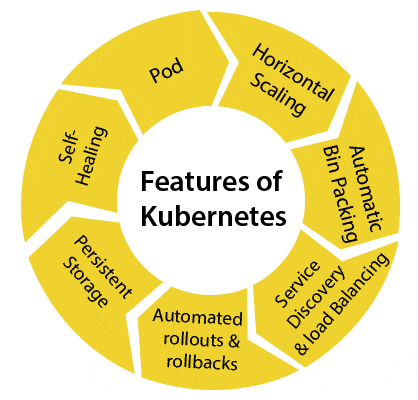Kubernetes Features
In this tutorial, we will discuss about Kubernetes Features. Kubernetes, often abbreviated as K8s, is an open-source platform designed for automating the deployment, scaling, and operation of application containers. It was originally developed by Google and is now maintained by the Cloud Native Computing Foundation (CNCF). Kubernetes provides a robust set of features that make it a powerful and popular choice for managing containerized applications. Here are some of the key Kubernetes features:

1. Pod
A pod is a deployment unit in Kubernetes with a single Internet protocol address. A pod is a collection of containers with shared storage and network and a specification for running them. Each pod is allocated its own IP address. Containers within a pod share this IP address, port space and can find each other via localhost.
2. Horizontal Scaling
It is an important feature in the Kubernetes. The Horizontal Pod Autoscaler automatically scales the number of Pods in a replication controller, deployment, replica set, or stateful set based on observed CPU utilization (or, with custom metrics support, on some other application-provided metrics)
3. Automatic Bin Packing
Kubernetes places containers automatically based on the required resources and other restrictions without impairing availability.
4. Service Discovery and load balancing
Kubernetes can expose a container using the DNS name or its own IP address. If traffic to a container is high, Kubernetes can load balance and distribute the network traffic to ensure stability.
5. Automated rollouts and rollbacks
Kubernetes progressively rolls out changes to your application or its configuration, while monitoring the application’s health to ensure it doesn’t kill all your instances at the same time. If something goes wrong, Kubernetes will rollback the change.
6. Persistent Storage
Kubernetes provides an essential feature called “persistent storage” for storing the data, which cannot lose after the pod is killed or rescheduled. Kubernetes supports various storage systems for storing the data, such as Google Compute Engine’s Persistent Disks (GCE PD) or Amazon Elastic Block Storage (EBS). It also provides the distributed file systems: NFS or GFS.
7. Self-Healing
This feature plays an essential role in the concept of Kubernetes. Kubernetes allows to replaces and reschedules containers when nodes die. It also kills containers that don’t respond to user-defined health checks and doesn’t advertise them to clients until they are ready to serve.
8. Run everywhere
Kubernetes is an open-source tool and gives you the freedom to take advantage of on-premises, hybrid, or public cloud infrastructure, letting you move workloads to anywhere you want
9. Secret and Configuration Management
Kubernetes allows you to manage sensitive information, such as passwords, OAuth tokens, and ssh keys. You can deploy and update secrets and application configuration without rebuilding your image and without exposing secrets in your stack configuration.
10. IPv4/IPv6 Dual-Stack
Kubernetes supports the assignment of IPv4 and IPv6 addresses to Pods and Services, facilitating the management of network resources in a dual-stack environment.
11. Multi-Tenancy
Kubernetes supports multi-tenancy, allowing different users or teams to share a Kubernetes cluster while isolating their workloads and resources.
12. Federation
Kubernetes federation allows you to manage multiple clusters as a single entity, providing a consistent control plane across different regions or clouds.
13. Helm Charts
Helm is a package manager for Kubernetes that allows you to define, install, and upgrade complex Kubernetes applications. Helm charts simplify the deployment and management of applications on Kubernetes.
14. Native Cloud Integration
Kubernetes integrates with cloud providers, enabling you to leverage cloud services directly from your Kubernetes clusters. This includes integrations for load balancers, storage solutions, and more.
15. Resource Monitoring and Logging
Kubernetes offers native support for monitoring and logging solutions, integrating with tools like Prometheus for monitoring and Fluentd for logging to provide insights into the performance and health of your applications.
Conclusion
Kubernetes is a comprehensive platform for managing containerized applications, offering a wide range of features that enhance deployment, scaling, and operational efficiency. Its powerful automation capabilities, extensibility, and robust ecosystem make it a leading choice for organizations looking to adopt container orchestration at scale
That’s all about the Kubernetes features. If you have any queries or feedback, please write us email at contact@waytoeasylearn.com. Enjoy learning, Enjoy Kubernetes.!!